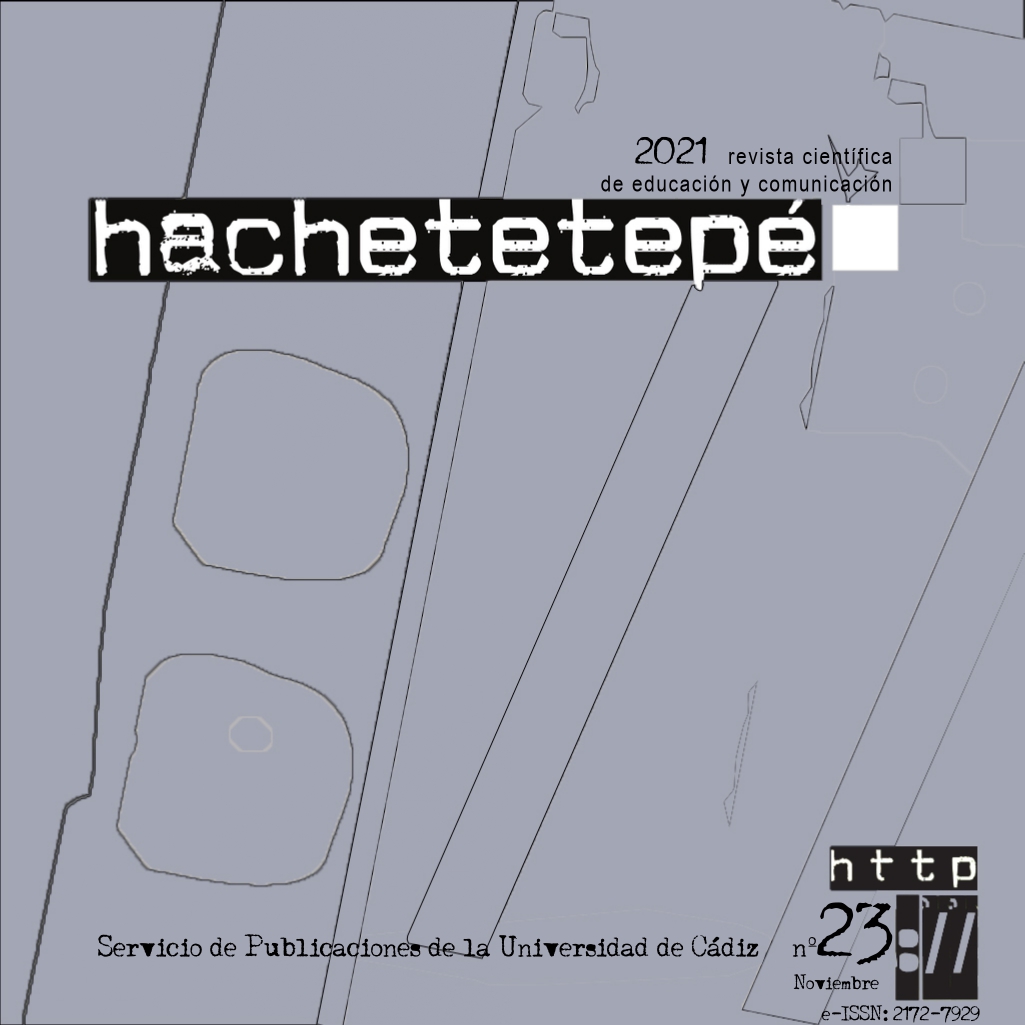Homophobic cyberbullying in Primary Education: towards a school free of homophobia

Downloads
- PDF (Español (España)) 858
- EPUB (Español (España)) 118
- VISOR (Español (España))
- MÓVIL (Español (España))
- XML (Español (España)) 15
DOI
https://doi.org/10.25267/Hachetetepe.2021.i23.2202Info
Abstract
In recent years, cyberbullying has increased alarmingly, due to the constant evolution of technology, together with the ever-decreasing age of access to technological devices. In addition, anonymity, and the lack of direct and immediate perception of the damage caused, make homophobic cyberbullying a great challenge that schools must overcome and provide answers to. We need to listen to the experiences and emotions of students who have been harassed for their sexual orientation in the school setting through technological devices. The objective of this article is to learn about the several consequences caused by homophobic cyberbullying. For this purpose, the biographical narrative methodology is used to give a voice to a sixth-grade student of Primary Education who has suffered homophobic cyberbullying by some of his classmates.Keywords
Downloads
How to Cite
License
Copyright (c) 2021 Begoña Sánchez-Torrejón

This work is licensed under a Creative Commons Attribution-NonCommercial-NoDerivatives 4.0 International License.
Those authors who have published with this journal, accept the following terms:
- They will retain their copyright and guarantee the journal the right to first publication of their work, which will simultaneously be subject to the Creative Commons Attribution License . They may be copied, used, disseminated, transmitted and publicly displayed, provided that the authorship, url, and magazine are cited, and are not used for commercial purposes. No derivative works are allowed.
- They may adopt other non-exclusive license agreements for the distribution of the published version of the work (e.g., deposit it in an institutional telematic archive or publish it in a monographic volume) provided that the initial publication in this journal is indicated.
- Disseminate your work through the Internet (e.g., in institutional telematic archives or on your website) once the manuscript is accepted, which may lead to interesting exchanges and increased citations of the published work. (See The effect of open access).
Hachetetepé. Scientific journal of education and communication does not charge a fee for the submission of manuscripts or for the publication of its articles.
References
Amar Rodríguez, V. (2016). Leer la vida. Una investigación desde la perspectiva narrativa. Revista Latinoamericana de Ciencias Sociales, Niñez y Juventud, 14 (2), 975-986.
Avilés, J.M. (2002). Bullying. Intimidación y maltrato entre alumnos. Steeseilas.
Barbero, M de S. (2017). Hacerse hombre en el aula: masculinidad,
homofobia y acoso escolar. Cadernos Pagu. (50), c175014. https://doi.org/10.1590/18094449201700500014
Bento, B. (2011). Na escola se aprende que a diferença faz a diferença. Estudos Feministas, 19 (2), 549-559.
Benítez, E. (2016). Ciberbullyng LGBT-fóbico. Nuevas formas de intolerância. Grupo de Educación de COGAM.
Borrillo, D. (2001). Homofobia. Bellaterra.
Carretero, R., y Nolasco, A. (2021). Acoso escolar y diversidad. Relación del acoso escolar con la percepción de normalidad en víctimas y agresores. Revista de Educación, (392) ,155-175.
Coll-Planas, G, Bustamante, G., y Missé, M. (2009). Transitant per les fronteres del gènere. Estratègies, trajectòries i aportacions de joves trans, lesbianes i gais. Colección Estudis, 25. Departament d'Acció Social i Ciutadania. Secretaria de Joventut.
Cristancho, M. K., y Niño, J. A. (2020). Estrategia de formación docente para la intervención en casos de ciberbullying. Infometric@ - Serie Sociales Y Humanas, 3(1), 109-130.
Del Río, C. (2010). El consentimiento informado en menores y adolescentes: Contexto ético-legal y algunas cuestiones problemáticas. Información psicológica, (100), 60-67.
Dorais, M. (2001). Mort ou fif. VLB Éditeur.
Garaigordobil, M., y Larrain, E. (2020). Acoso y ciberacoso en adolescentes LGTB: Prevalencia y efectos en la salud mental. Comunicar, 28(62), 79-90. https://doi.org/10.3916/C62-2020-07
Giménez, A. G. (2015). Cyberbullying. Análisis de su incidencia entre estudiantes y percepciones del profesorado [Tesis doctoral]. Universidad de Murcia. https://bit.ly/36NixIH
Gómez, A.B. (2005). El impacto de la homofobia y el bullying anti gay en los/as jóvenes. En J. Genérelo y J.I. Pichardo (Coords), Homofobia en el sistema educativo (pp.93-105). Cogam.
González, F (1997). Epistemología cualitativa y subjetividad. Pueblo y Educación.
González-Ávila, M (2002). Aspectos éticos de la investigación cualitativa. Revista iberoamericana de educación, 29, 85-103.
Hernáiz Landáez, E., y Márquez Santander, D. (2011). Manual educativo para la diversidad. Fundación para los reflejos de Venezuela.
Herrera, M., Romera, E., y Ortega-Ruiz, R. (2018) Bullying y cyberbullying en latinoamérica. Un estudio bibliométrico. Revista Mexicana de Investigación Educativa, 23(76), 125-155.
Institución del Ararteko (2011). Informe Infancias Vulnerables. Parlamento Vasco.
Lauretis, T. (1987). A tecnologia do gênero. University Press.
Molinuero, B. (2007) Actitudes ante la diversidad sexual de la población adolescente de Coslada (Madrid) y San Bartolomé de Tirajana (Gran Canaria). Ayuntamientos de Coslada y San Bartolomé de Tirajana. Federación Estatal de Lesbianas, Gays, Transexuales y Bisexuales.
Mendoza, E. (2012). Acoso cibernético o cyberbullying: Acoso con la tecnología electrónica. Pediatría de México, 14 (3), 133-146.
Palacios, V., Polo, Mª I., Felipe, E., León, B., y Fajardo Bullón, F. (2013). European Journal of Investigation in Health, Psychology and Education, 3(2), 161-170.
Platero, R. y Gómez, E. (2007). Herramientas para combatir el bullying homofóbico. Editorial Talasa.
Plummer, D. (2001). The Quest for Modern Manhood: Masculine Stereotypes, PeerCulture and the Social Significance of Homophobia. Journal of Adolescence, 24(1), 15-23.
Price, J.H., y Murnan, J. (2004). Research Limitations and the Necessity of Reporting Them. American Journal of Health Education, 35(2), 66-67.
Rich, A. (2012). Heterossexualidade compulsória e existência lésbica. Bagoas - Estudos gays: gêneros e sexualidades, 4(5), 18-44.
Sánchez Torrejón, B. (2021). La formación del profesorado de Educación Primaria en diversidad sexo-genérica. Revista Electrónica Interuniversitaria de Formación del Profesorado, 24(1), 253-266. https://doi.org/10.6018/reifop.393781
Sandín Esteban, M.P. (2003). Investigación cualitativa en educación: fundamentos y tradiciones. McGraw-Hill.
Takács, J. (2006). Social exclusion of young lesbian, gay, bisexual and transgenderpeople (LGBT) in Europe. ILGA Europe.
Taylor, S., y Bogdan, R. (1986). Introducción a los métodos cualitativos de investigación. La búsqueda de significados. Paidós.






